Currently on display in our pop-up exhibit cases are items relating to the life of Lucy E. Parsons, an anarchist and activist in the late 19th and early 20th centuries. Lucy Parsons, born in approximately 1853, was the child of enslaved parents. She grew up in Texas and while working she met and married Confederate Soldier Albert Parsons. Shortly thereafter, they began advocating for voter rights for emancipated slaves. Lucy and Albert opposed the U.S. bans on mixed race marriages and operated an anti-capitalism press in Texas, which resulted in an act of violence against Albert that led to their arrival in Chicago c. 1872.
While living in Chicago, Lucy became an activist leading work stoppages and many labor protests. This was the beginning of unions that included Black women. However, Lucy identified as Native American and Mexican. Lucy Parsons became the most vocal woman of color in Chicago during this time. Lucy and Albert worked as contributing writers for U.S. labor, union, and socialist newspapers. Just over a decade after moving to Chicago, they established the anarchist newspaper, The Alarm. Lucy was a contributing writer and Albert acted as the editor. They both were in the ranks of the Socialist Labor Party (SLP) established in 1876. Their life together is uniquely tied to anti-capitalist views and later Socialism and Communism.
Lucy and Albert decided to participate in the events that would come to be known as the Haymarket Riots. Initially the event was to support the striking employees of McCormick Harvest Works in Chicago. The employees went on strike May 3rd, 1886, demanding an eight-hour work day. The Chicago Police Department were sent to Haymarket Square, the situation escalated, and peaceful protesters were fatally shot. More than 2,000 workers, citizens, and families gathered in outrage on May 4th, 1886 at Haymarket Square. During the event, a bomb exploded in the crowd killing seven Chicago Police Officers, several bystanders, and injuring hundreds. When the smoke cleared, Albert Parsons was one of five men accused of the bombing at the Haymarket Riots.
On November 11, 1887, Albert Parsons and three other men were sentenced and hung at Joliet State Prison. Throughout this tragedy, Lucy Parsons did not stay silent and continued her work as an activist. While Albert was in Cook County Jail, Lucy sold publications to raise funds for his legal defense. She continued their work as activists despite his imprisonment and eventual death. Although she was not successful in freeing Albert from prison, he was pardoned posthumously by Governor John P. Altgeld. Upon Gov. Altgeld’s death, Lucy published Gov. John P. Altgeld’s Pardon of the Anarchists and Masterly Review of the Haymarket Riot, which is currently on display at the Rare Book and Manuscript Library.
The items in A Woman’s Place in Anarchy: Lucy E. Parsons and the Haymarket Riots have been selected for their connections to the events that occurred during Lucy’s lifetime. They cover subjects ranging from labor relations, to social expectations, and the emergence of an independent woman’s voice. They are meant to provide the context for the era of her life. Society placed harsh expectations on Lucy. She moved the boundaries of her role as wife, mother, working woman, and woman of color. Explore some items from the exhibit below.
Items in the exhibit:
Lucy Parsons letter to Ewing Cannon Baskette. Ewing Cannon Baskette Collection, Vol. 26 (Box 13)
George Plechanoff, Ewing Cannon, Anarchism and Socialism. Chicago: C.H. Kerr, [1907].
Barnes, Sarah Witte. Columbia Book of Bouclette Fashion Ensembles for Misses and Women. Philadelphia: Wm. H. Horstmann Company, 1933.
Walter, Nicolas. Anarchist of Chicago: 1886 Haymarket 1986. London: Freedom Press, 1986.
Russell, Malinda. Domestic Cook Book: Containing a Careful Selection for Useful Receipts for the Kitchen. Paw Paw , MI: T.G. Ward, 1866.
Lucy Parsons Chapter, New American Movement. Lucy Parson’s Recipes for a Red Planet. [1978]. [currently uncatalogued]
Post, Emily. Etiquette in Society, In Business, In Politics and at Home. New York: Funk & Wagnalls Co., 1922.
Lucy Parsons letter to Ewing Cannon Baskette. Ewing Cannon Baskette Collection.
Lucy Parsons postcard to Ewing Cannon Baskette, 1943. Ewing Cannon Baskette Collection.
Altgeld, John P., Parsons, Lucy E., Gov. John P. Altgeld’s Pardon of the Anarchists and Masterly Review of the Haymarket Riot. Chicago: Lucy E. Parsons Publishers, [1915].
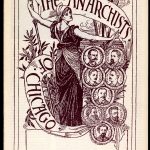
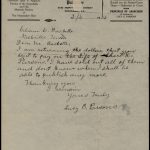
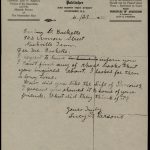
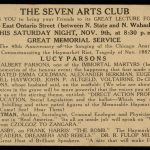
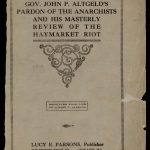
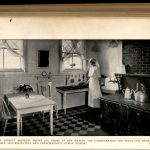

I am looking for quote by L.P. from her last public speech to CIO union Farm Equipment workers who were striking in Chicago during February, 1941. This info will help me complete my short biog. sketch for the Online Biog. Dictionary for the Women’s Suffrage Mov’t. commissioned by Illinois 2020 director, Lori Osborne. Thanks.